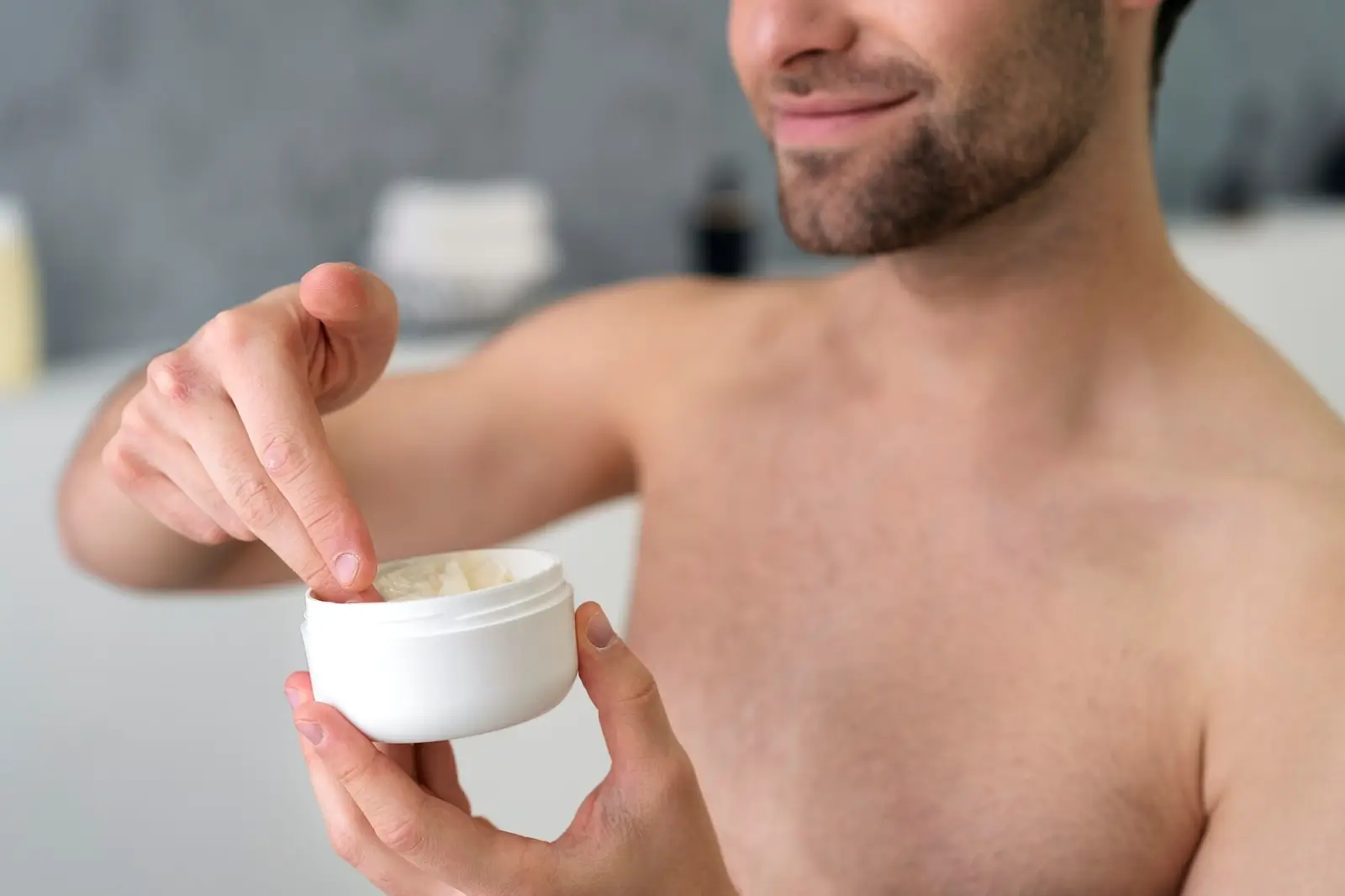Business Hours: Monday - Friday: 9 AM - 6 PM EST

EMLA Cream for Premature Ejaculation – Is It Effective?
David Fuller
Last Updated On: April 10, 2025
Premature ejaculation (PE) is one of the most common forms of male sexual dysfunction, affecting approximately 30% of men worldwide. Characterized by short ejaculatory latency, PE can cause emotional distress and reduce satisfaction within intimate relationships. Treatment options typically include behavioral therapy, oral medications, and topical anesthetics.
One topical solution gaining attention is EMLA cream, a formulation of lidocaine and prilocaine originally designed for pain relief in dermatological and medical procedures. Due to its numbing effect, some studies suggest that EMLA may also be useful in managing PE by increasing intravaginal ejaculatory latency time (IELT).
This article explores the effectiveness of EMLA cream for premature ejaculation (PE), how it works, its potential side effects, and safe usage guidelines to help individuals make informed decisions.
Key Takeaways
- EMLA cream contains lidocaine and prilocaine, local anesthetics that numb the skin, helping men with premature ejaculation (PE) gain better control over climax.
- It should be applied 15–30 minutes before intercourse and washed off before penetration to prevent numbing the partner.
- Clinical studies indicate that EMLA can significantly improve intravaginal ejaculation latency time (IELT), with some users experiencing a 2- to 6-fold increase compared to placebo.
- Over 70% of users report improvements in sexual satisfaction and ejaculation control.
- Common side effects include temporary numbness and mild irritation, while serious side effects are rare but may include allergic reactions.
- EMLA is one of several topical treatments for PE. It is practical and available and requires careful application compared to other options like lidocaine sprays and desensitizing condoms.
- To ensure optimal results, use EMLA cream as needed, adhering to proper dosage and application guidelines to balance effectiveness and sensation.
About: Operating since 2016, Med Supply Solutions is known for being one of the industry’s top and trusted suppliers of cosmetic and viscosupplementation products. Contact our sales department for more information about buying EMLA cream online.

Overview of EMLA Cream in Premature Ejaculation Treatment

EMLA cream contains lidocaine and prilocaine, two local anesthetics that temporarily numb the skin by reducing nerve sensitivity. While originally developed for medical and dermatological procedures, studies have shown that it may also help delay ejaculation by decreasing penile sensitivity. This effect can give men with premature ejaculation (PE) more control over climax and improve sexual satisfaction.
The cream is typically applied 15–30 minutes before intercourse and must be washed off before penetration to avoid numbing the partner. Unlike oral medications, EMLA works locally, limiting the risk of systemic side effects. Though not FDA-approved for PE, its off-label use has gained popularity among healthcare providers and patients alike due to its accessibility and effectiveness.
Review of Clinical Evidence and Patient Outcomes

Several clinical studies have assessed the efficacy of EMLA cream in treating premature ejaculation. Results consistently show a significant increase in intravaginal ejaculation latency time (IELT) for men using topical anesthetics.
As part of broader EMLA Cream uses, its role in managing PE has gained growing interest among clinicians due to its localized action and minimal systemic effects.
Key Findings from Clinical Studies
- A randomized clinical trial showed that men using EMLA experienced a 2- to 6-fold increase in IELT compared to a placebo group.
- Another study reported that over 70% of participants saw improvements in ejaculatory control and sexual satisfaction.
- Most side effects were mild, such as temporary numbness, and were generally well tolerated by users.
Application Methods and Dosing Strategies for PE Management
Correct application is critical to achieving the desired effect and avoiding discomfort. Here is a recommended usage strategy:
Application Guidelines
- Apply a pea-sized amount to the glans penis around 15–30 minutes before intercourse.
- Massage gently to aid absorption.
- Thoroughly wash off before intercourse to prevent partner transfer.
- Use only as needed; overuse can lead to irritation or decreased pleasure.
Potential Side Effects and Patient Adherence Considerations
While EMLA cream is generally safe, some users may experience side effects, especially with improper or excessive use.
Common Side Effects
- Temporary numbness at the application site
- Mild burning or tingling sensation
- Reduced sensitivity, which may affect orgasm
Less Common but Serious Side Effects
- Allergic reactions (e.g., redness, itching, swelling)
- Over-numbing, which may reduce enjoyment
- Numbness in partners if not properly cleaned off
To enhance comfort and patient adherence, it is advised to start with a small dose, monitor the body’s response, and always follow proper timing and hygiene.
Comparative Analysis with Other Topical Treatments
While EMLA is a strong contender, there are other topical treatments available for PE. Here’s how they compare:
| Treatment | Pros | Cons |
| EMLA Cream | Clinically proven, widely available | Requires careful use and pre-intercourse washing |
| Lidocaine Spray | Convenient, fast-acting | Risk of over-numbing; limited evidence for some brands |
| Desensitizing Condoms | Easy to use, minimal partner transfer risk | May dull sensation excessively |
| Oral Medications | Systemic control over time | Requires a prescription; may cause broader side effects |
Conclusion
EMLA cream for premature ejaculation presents a practical and effective off-label solution. By reducing penile sensitivity, it helps delay ejaculation and enhance sexual confidence. Clinical data supports its use, and with proper application, side effects can be minimal. Compared to other options, EMLA offers a balanced blend of efficacy, accessibility, and localized action.
EMLA cream ranks among the most versatile uses for men looking for noninvasive management of PE. When used correctly, it provides targeted relief with minimal systemic involvement.
FAQs
1. How long does EMLA cream last for premature ejaculation?
Depending on skin absorption and application amount, EMLA’s numbing effect can last 1 to 4 hours. Most users experience the peak effect within 1–2 hours. To ensure the best results, apply 15–30 minutes before intercourse and wash it off before penetration.
2. Can I use EMLA cream every time I have intercourse?
Yes, but it is recommended that EMLA be used only as needed. Frequent use may lead to reduced sensitivity over time or mild irritation. If you need to apply it often, consult a doctor to discuss alternative PE treatments.
3. Can my partner experience numbness from EMLA cream?
Yes, if the cream is not washed off properly before intercourse, your partner may experience temporary numbness. To prevent this, wash the area thoroughly after absorption and consider using a condom.
4. Can EMLA cream weaken condoms?
Yes, EMLA cream is oil-based and can weaken latex condoms, increasing the risk of breakage. Use polyurethane condoms instead to maintain protection against pregnancy and STIs.
5. Is EMLA cream safe for everyone?
EMLA is generally safe for men over 18 but should not be used by those with G6PD deficiency, methaemoglobinaemia, or open wounds on the penis. Always consult a healthcare provider before use.
References
Atan A, Basar MM, Tuncel A, Ferhat M, Agras K, Tekdogan U. Comparison of efficacy of sildenafil-only, sildenafil plus topical EMLA cream, and topical EMLA-cream-only in treatment of premature ejaculation. Urology. 2006;67(2):388-391. doi:10.1016/j.urology.2005.09.002
Atikeler MK, Gecit I, Senol FA. Optimum usage of prilocaine-lidocaine cream in premature ejaculation. Andrologia. 2002;34(6):356-359. doi:10.1046/j.1439-0272.2002.00511.x
Products
Cart
Log In
Newsletter
Subscribe for exclusive offers and updates on new arrivals
Share feedback at:
Working Hours
Monday to Friday: 9 AM to 6 PM EST
The Most Popular Brands
Med Supply Solutions
Support
Copyright 2025. Med Supply Solutions